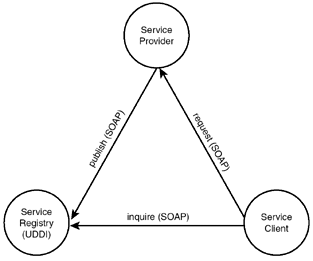Introduction
| Now it's time to answer these questions: How can I advertise my Web service? What is the best searching mechanism that will produce the most precise and appropriate list of possible Web services that will meet my needs? This chapter briefly introduces the standard in Web service registries, Universal Description, Discovery, and Integration (UDDI), and what it has to offer. UDDI is an initiative conceived and sponsored by a private consortium of technology companies named uddi.org. This chapter then explains how WebLogic Server supports this technology. Prior knowledge of UDDI (the UDDI API and its data structures) is presumed and is necessary for comprehending the concepts in this chapter. More information on UDDI can be found at www.uddi.org. The service-oriented architecture of Web services is shown in Figure 31.1. Figure 31.1. Players in a Web service-oriented architecture. A service provider offers some Web services, but these services are useless if no client knows about them. Hence, the provider publishes its services in a UDDI registry. A client can then search or browse a UDDI registry to discover Web services that meet its needs. When an appropriate service is found, the client then invokes the service from the provider. Service discovery can occur at two possible junctures:
Again, it is not the intent of this chapter to provide a full treatise on UDDI. The goal is to provide a simplified and high-level discussion of the UDDI technology and to point out what WebLogic Server 7.0 features support UDDI. |
EAN: 2147483647
Pages: 360
